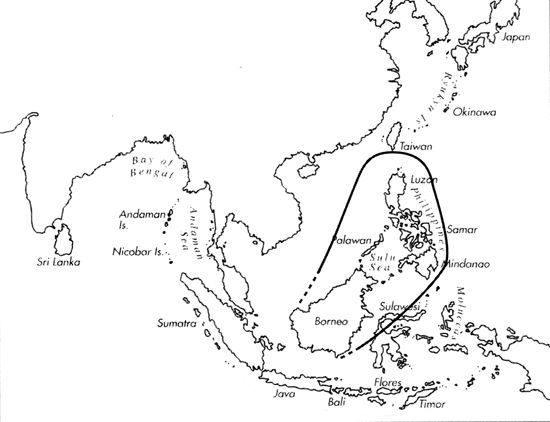Range: Philippines and Borneo.
Description: Medium-sized to moderately large, moderately solid. Last whorl narrowly conoid-cylindrical to narrowly conical, rarely conical to ventricosely conical; outline slightly convex on adapical third, straight below. Basal part of columella often deflected to left. Shoulder angulate to sharply angulate. Spire of low to moderate height, outline slightly concave to straight. Maximum diameter of larval shell about 0.8 mm. First 3- 4 teleoconch spire whorls weakly tuberculate. Teleoconch sutural ramps flat to slightly concave, with 1 increasing to 4-5 spiral grooves. Last whorl with axially striate spiral grooves from base to shoulder and variably broad ribbons between; toward base, grooves wider and partially with a spiral thread, infervening ribbons sometimes weakly granulose; below shoulder, ribbons narrow or grading to ribs.
| Shell Morphometry | ||
|---|---|---|
| L | 41-64 mm | |
| RW | 0.11-0.25 g/mm | |
| RD | 0.42-0.51 | |
| PMD | 0.80-0.88 | |
| RSH | 0.10-0.16 | |
Ground colour white, often suffused with beige or violet. Last whorl with brown dots, dashes and flecks on the spiral ribbons, concentrated in an interupted spiral band above and below centre. Larval whorls greyish white. Teleoconch spire with curved radial brown streaks and blotches. Aperture bluish violet, demarcated by a darker collabral band from a white marginal zone.
Periostracum olive-grey, thin, translucent, smooth.
Habitat and Habits: In 50-240 m.
Discussion: C. laterculatus is very similar to C. australis australis, which differs in its larger size (L to 105 mm), its generally higher higher spire (RSH 0.14-0.21), less angulate shoulder, and more prominent and granulose spiral elevations on the last whorl. C. laterculatus generally lacks the axial streaks and flames characteristic of the last whorl of C. australis, and the aperture of C. laterculatus is darker. For distinctions from C. sculpturatus, see the Discussion of the later species.

C. laterculatus range map
This section contains verbatim reproductions of the accounts of 316 species of Conus from the Indo-Pacific region, from Manual of the Living Conidae, by Röckel, Korn and Kohn (1995). They are reproduced with the kind permission of the present publisher, Conchbooks.
All plates and figures referred to in the text are also in Röckel, Korn & Kohn, 1995. Manual of the Living Conidae Vol. 1: Indo-Pacific Region.
The range maps have been modified so that each species account has it own map, rather than one map that showed the ranges of several species in the original work. This was necessary because each species account is on a separate page on the website and not confined to the order of accounts in the book.